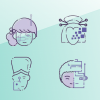Related Content
 |
Designing Data Models for Self-Documented Tests When testing applications, documenting and interpreting test results can be a challenge. Data models enable us to collect and process test data more dynamically and uniformly. To design effective data models for self-documented tests, there are three important things to consider: what to document, collect, and report. |
|
 |
Stop Email Overload and Communicate Better Many of us fire off correspondence to groups and distribution lists that include more recipients than necessary, and we overcommunicate without stopping to think about exactly what needs to be conveyed. Here are some ways organizations and teams can cope with the influx of information and communicate intentionally. |
|
 |
Change Is Hard, but BDD Is Worth It Behavior-driven development is a methodology change that impacts the whole team, and unfortunately, it’s not as easy as writing scenarios in a specific format. What is the added value of BDD? Why should the team throw their current process out the window and try to incorporate a new methodology? Here are some reasons. |
|
 |
Making the Product and Development Partnership Thrive The product manager and the development lead partnering well together is a cornerstone of great product teams. The behavior they exhibit sets the standard for how the team cooperates, connects, and thrives. One great way to do this is getting closer to your customer. Here’s how this advice works with both protagonists. |
|
 |
When Field Testing Isn’t Possible, Use Simulation Field testing is great for discovering different situations, but due to a variety of constraints, it may not always be possible. In such cases, simulation is useful to create a picture that mimics the real scenario. You can replicate hardware, operating systems, network ranges, and more, as well as nonfunctional areas. |
|
 |
Using Design Thinking to Create Better Test Cases Design thinking is a user-centric framework to solve a business challenge by delivering the best user experience. Using design thinking, you can better frame the business drivers, select the right persona to focus on, design your user journey, identify test scenarios, pinpoint user pains, and write better test cases. |
|
 |
Building Culturally Inclusive AI Models For us to build the most effective technology, we need to learn from our past and build our future with more comprehensive data sets with cultural intelligence. This means AI that recognizes your story, chatbots that speak to you more authentically, and smart assistants that have inclusive data about your ancestry. |
|
 |
DevOps Transformations for QA Teams: A Slack Takeover with Stacy Kirk Thought leaders from the software community are taking over the TechWell Hub to answer questions and engage in conversations. QA architect an agile coach Stacy Kirk, founder of QualityWorks Consulting Group LLC and nodeqa.io, hosted this Slack takeover and discussed improving teams by implementing DevOps practices. |








